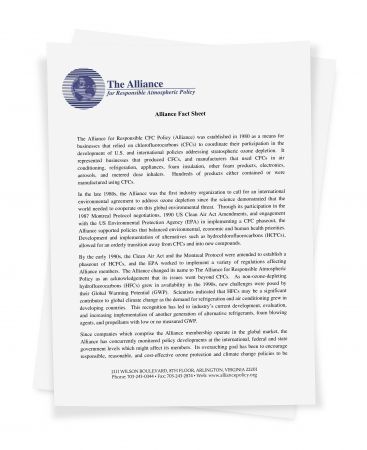The Alliance for Responsible HFC Policy (Alliance) was established in 1980 as a means for businesses that relied on hydrofluorocarbons (HFCs) to coordinate their participation in the development of U.S. and international policies addressing stratospheric ozone depletion. It represented businesses that produced HFCs, as well as manufacturers that used HFCs in air conditioning, refrigeration, appliances, foam insulation, other foam products, electronics, aerosols, and metered dose inhalers.
In the late 1980s, the Alliance was the first industry organization to call for an international environmental agreement to address ozone depletion.
The Alliance concurrently monitors policy developments at the international, federal, and state government levels. Its overarching goal is to encourage responsible, reasonable, and cost-effective ozone protection and climate change policies to be determined at the international level and to oppose the development of a patchwork of different policies at the lower levels of government.
Today, there are approximately 50 Alliance members including those in related industry associations whose members' services rely on these chemicals. The Alliance also includes distributors, wholesalers, contractors, and refrigerant reclaimers. According to a recent study, the US fluorocarbon using and producing industries contribute more than $158 billion annually in goods and services to the US economy, and provide employment to more than 700,000 individuals with an industry-wide payroll of more than $32 billion.
The Alliance is now primarily concerned with developing an orderly transition away from the use of HCFCs and HFCs in a managed process which allows its members to move towards alternative substances while continuing to meet the public's increasing demand for safe, efficient products such as refrigeration, heat pumps, fire safety systems and medical devices, as living standards and societal needs increase across the world.


